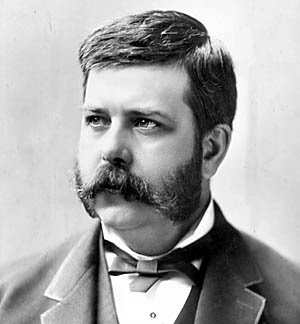What do you think of when you hear the name Westinghouse? Perhaps you think of the revolutionary air brake patent that ensured safe train travel; maybe you remember reading about the Electric War “fought” between George Westinghouse and Thomas Edison; or possibly Westinghouse stands out as the genius industrialist who powered homes, fairs, and streets. Regardless of how you know Westinghouse, it is a guarantee you have used something invented by George Westinghouse himself or under the Westinghouse name. With nearly 400 patents to his name, Westinghouse is a beacon of Gilded Age industry.
George Westinghouse, Jr. (1846-1914) was born in Central Bridge, NY to Emeline and George Westinghouse, Sr., the latest in a family of inventors. His father designed and manufactured agricultural tools, creating an environment that taught Westinghouse about the importance of technological innovation and spurring his lifelong passion for engineering and mechanics. Exploring new technologies was something he loved. Any formal plans for education were paused when, in 1862 at age 15, Westinghouse enlisted in the New York National Guard, ready to fight in the American Civil War. He returned home soon after at his parents’ request, but re-enlisted a year later, joining the Union’s 16th New York Cavalry. Commissioned as an Acting Third Assistant Engineer in the Union Navy, Westinghouse served in this position for the final year of the war before being honorably discharged in August 1865.
After his service, Westinghouse returned to the capital region of New York and enrolled at Union College to study engineering. He became dissatisfied with the curriculum and dropped out to pursue personal studies and engineering work, which paid off quickly. At 19, Westinghouse received a patent for a rotary steam engine, the first of his 361 total patents and an invention he continued to improve. His next two patents, the reversible frog and the air brake, drove him even deeper into the world of industrialism. Both inventions were spurred by the constant American and British locomotive accidents, such as the Angola Horror and the Shohola train wreck. Railways needed easier mechanisms for switching trains from track to track, which is exactly what Westinghouse’s reversible frog– or “car-replacer”–did. Many wrecks also resulted from slow braking, since car brakes were individually set by engineers. In 1869, Westinghouse patented a fail-safe air brake system which let locomotives brake faster to prevent collisions. Engineers triggered the brake from one location and if one car’s brakes malfunctioned, the fail-safe system stopped the whole train. That same year, Westinghouse opened his first factory, the Westinghouse Air Brake Company.
Westinghouse became a major entrepreneur during the Industrial Revolution, opening 61 factories and sub-companies globally. Each company manufactured machine parts patented either by Westinghouse or others under his umbrella, such as Nikola Tesla, Peter Cooper-Hewitt, William Stanley, and Bertha Lamme, who has been described as the country’s first female electrical engineer. Roughly 6,000-9,000 employees worked at the three factories in Pittsburgh, the Westinghouse capital. Next to the factories was the company town, Wilmerding, where Westinghouse built a YMCA, developed continuing education and training programs, and encouraged employee recreation time. He was the first industrialist to give off Saturday afternoons in addition to Sundays, more time for rest and recreation, which improved employee productivity. There were even pension, unemployment, and home ownership plans that helped employees also be successful outside of the factory.
While Westinghouse was in charge, few strikes occurred, a sign of employee contentment and a result of Westinghouse’s general willingness to listen to employee concerns. However, in 1903, a strike led to Westinghouse replacing hundreds of employees rather than talk with strikers. The strike ended when they realized Westinghouse would not budge. Despite this incident, he was a benevolent industrialist compared to the likes of fellow Pittsburgh tycoons Andrew Carnegie and Henry Clay Frick.
Westinghouse shifted his focus from frogs and air brakes to new electro-pneumatic railway signals which ran on electric and gas power rather than the antiquated oil lamps signalmen used before. The Union Switch & Signal Company was the first to make these new tools for train safety. Westinghouse’s use of natural gas to power signal lights resulted from a passion project in Pittsburgh’s Point Breeze neighborhood. There, Westinghouse built his home, “Solitude.” The magnificent mansion housed the Westinghouses when they were in the city, which was often, despite a penchant for traveling. By 1884, Solitude became known for another reason: it was the site of Westinghouse’s natural gas experiments. Westinghouse was interested in trying to harness the power of what was then a feared substance. Workers opened a ground vent to release the gas that inspired Westinghouse gas meters and stopcocks to measure and control gas. At one point, he even set a burst of gas on fire just to amaze guests. For Western Pennsylvania, Westinghouse’s developments made using natural gas safer, and significantly expanded the region’s gas industry, as his inventions would do with water power farther north.





No comments:
Post a Comment